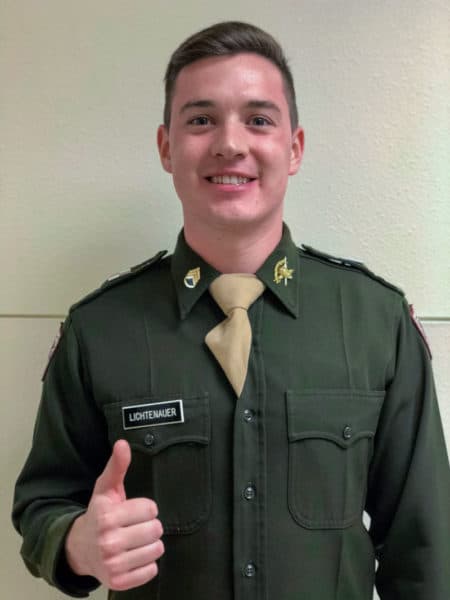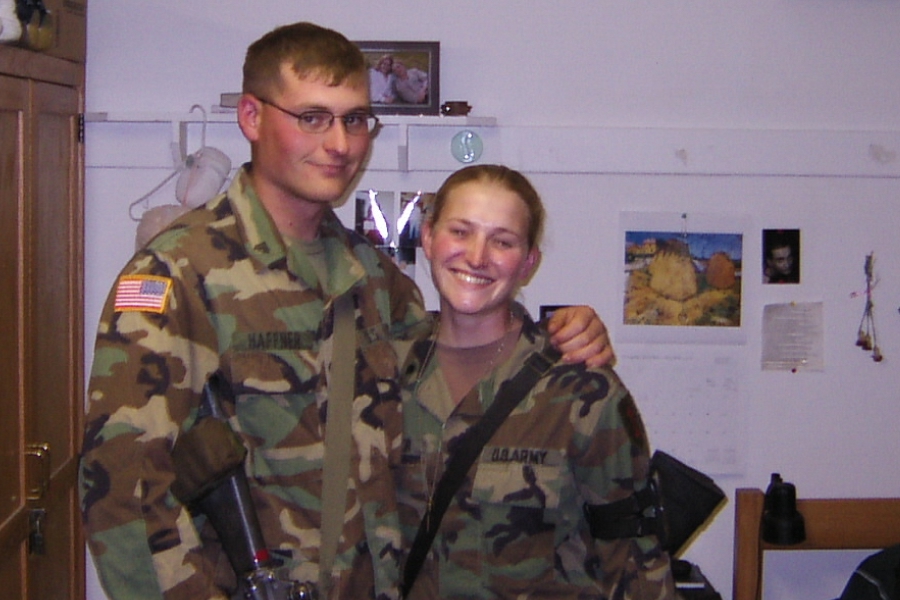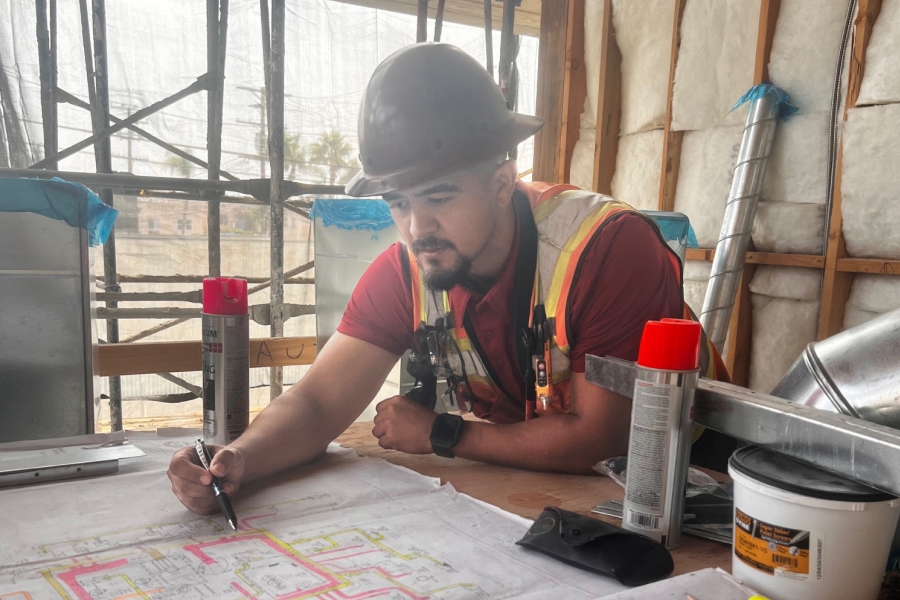Andrew Lichtenauer is a junior in the construction science program at Texas A&M University in College Station. He is also a member of the Texas A&M Corps of Cadets. During the spring and summer of 2018, Lichtenauer had the opportunity to work for Power Construction on the Residences at Addison & Clark, a residential complex across from Wrigley Field in Chicago. The Bluebeam blog spoke with Lichtenauer about what sparked his interest in AEC, rethinking the skilled trades, and technology in construction.

Built Blog: What got you interested in construction? Had you worked in the industry before you started at Texas A&M?
Lichtenauer: I came to A&M as a political science major very unsure of what I wanted to do in the future. I became good friends with a few people in the construction science program who spoke very highly of what they were studying. I also saw they had a level of interest in their major that I really didn’t have in my current one, and so I switched into the program. The dedication of the professors in the construction science program got me really excited about working in the industry because I felt that I was really learning about things that were going to directly apply to a job after school. The other students are all great as well and there is a really collaborative environment in the department. I had never worked specifically in construction before switching my major. However, I had worked with my uncle’s landscaping company and the public works department in my hometown of Western Springs, Illinois, for two summers.
Built Blog: Construction executives frequently talk about a crisis in construction: there’s a shortage of young people who want to work in the industry. Do you believe this is the case? If so, what do you think are the reasons behind it?
From the perspective of a construction science student, the shortage of young people interested in the industry is apparent especially from the amount of job offers and availability of jobs for us as graduates. More broadly we are told the larger labor shortage issue is in young people entering into a skilled trade position, which I agree with. As a high school graduate, you may hear about opportunities in skilled trade positions as an alternative to college, and even though having a college degree alone doesn’t necessarily set you apart from your peers as much as it used to, there is still a draw towards the college experience that people don’t want to miss out on. I think that because of this going to college and working as a skilled tradesman are regarded as mutually exclusive options by high school graduates. If skilled trade positions were regarded as an option after college instead of an alternative to college, young people wouldn’t write them off as quickly.
Built Blog: What is your area of concentration? Why did you choose that area, and how do you see yourself working in the field in this area in the future?
I don’t have a specific concentration as a construction science student. However, I am interested in becoming a superintendent for a commercial general contractor. Being a superintendent interests me because of the level of specific trade knowledge they have to have to manage the field operations. Managing the people in the field who are doing the physical work seems to require a level of interpersonal skills combined with a level of expertise that takes a lot of work to attain. That challenge excites me and is a sizeable goal that keeps me motivated to learn new things everyday about any aspect of the industry.
Built Blog: How important is technology to your studies? And in your opinion, to the future of AEC?
Technology is very important at A&M and should be a focus of someone who wants to be in the AEC industry. Being able to effectively use a certain software or program in my opinion is being seen as more of a prerequisite to performing your job especially since a lot of these programs are becoming available to students for use in the classroom and their own use. We have been learning to work with programs such as On-Screen Takeoff, Bluebeam and Procore in our daily classes and have even had the opportunity to use more advanced technology like Matterport 3D scanning in project management classes. While keeping up with technology can be a challenge in itself, it can also be one of the most lucrative tools because every new technology is increasing the span of control that an individual has on the jobsite.
Built Blog: What are some of the technologies you’ve been most interested in?
The project manager at the job I was on for my internship with Power Construction was really proficient at using Bluebeam and so every chance he got, he would give me tips on more efficiently using it or he would show me different features I had no idea existed. I used it heavily every day on the internship whether it was marking up a drawing to give to a tradesman, during shop drawing review, or even quick QTOs. I quickly saw that as a young project engineer, knowing Bluebeam in and out would be very helpful and could set me apart. I also really enjoyed using OST at A&M in my estimating class.
Built Blog: Have you used Bluebeam Revu? If so, how? What are the greatest benefits of using the software?
I used Bluebeam Revu every day on my internship, mostly posting RFIs to our drawing set, marking up shop drawings, or marking up drawings for my own reference in the field. It was very useful for a lot of the tasks I was doing on a day-to-day basis but I found the greatest benefit in some of the huge time saving features. For example, I had heard stories of interns in the past who would spend a great deal of time hyperlinking drawings and naming pages by hand. The batch label and hyperlink feature that lets you use page areas to search and assign page labels or hyperlinks based on the detail and page number makes something that could take an intern a week on a large drawing set, you can do in minutes. While that is only the beginning, I really enjoyed learning more about functions like this on Bluebeam that let you spend more time focusing on less tedious matters.
Built Blog: Do you think mastering tech will give you a leg up in the future?
Absolutely. A professor at A&M gave us an example of how he experimented with macros and writing code in Excel to come up with functionalities in his spreadsheets that checked for errors in his line item calculations that would be otherwise easy to miss by the human eye. He said those skills that he learned himself just by using the program and experimenting made him an invaluable asset to the company. Proficiency with technology is something that A&M preaches by letting us use and have access to a lot of the programs we will be using on the jobsite.
Built Blog: Can you tell me about one or two of your favorite projects you’ve done at Texas A&M? That could be conferences, class projects, internships or externships.
At A&M my favorite project(s) were the estimates I did in the second estimating class. We were doing takeoff for the most part on one set of drawings from a project in California and did multiple different takeoffs ranging from demolition, unit finishes and façade. Then at the end of the semester we got to run a bid day scenario in class where we received subcontractor bids for different trades and did a bid tab analysis to come up with a number for the project.
The internship I did with Power Construction in Chicago has been my favorite construction experience while at Texas A&M. I worked on a mixed-use retail/residential project right across from Wrigley Field for eight months. The team that I was working with was awesome and they really gave me a lot of autonomy on the things I was working on which was such a valuable learning experience. I worked on the enclosure with one of the superintendents helping with submittals, RFIs and QC early on in the job. As I learned more, I was given a few submittal package reviews like the louvers and overhead doors, and I even got to coordinate most of the swimming pool and louver installation, being the primary contact with the subcontractors. Working with the subcontractors in the field and working out issues and keeping track of everything was the most enjoyable part of the internship. Not to mention every one on the team had so much knowledge to offer. There was never a dull moment on the jobsite and I left in August feeling like I was really a part of the team.
Built Blog: How did you end up at Intern Day in Chicago? Were you interning for a company there? How did you find it? It’s also very cool that you were at XCON. What sessions did you go to? What did you find useful there? Did you network?
I ended up at the Bluebeam Intern Day in Chicago when the PM on the job I was working on recommended me as one of four interns to represent Power during the conference. I was fortunate enough to talk with Emily Heppard, who’s with Bluebeam’s Academic program, who mentioned that XCON was in Austin and that I could attend as a student since I was so close at A&M. Some of the sessions I attended were Material Takeoffs and Estimates, Tips and Tricks Basics, and Empowering the Field with Apps. I learned a lot at the estimating workshop I attended. There were a lot of ways to set up your markups using conditions that can make them into really useful takeoff tools. I thought it would be interesting to experiment with these the next time I was working on a job. Unfortunately I only was able to attend one of the days, but I did get to meet people from a few companies including Siemens and Premier Mechanical, one of the companies that Power works with.
Built Blog: Finally, are you currently looking for a job? How can prospective employers contact you?
I’m excited to have just accepted another summer position as an estimating intern with Power Construction. I always enjoy networking with others and learning about different companies. The best way to reach me is by my school email: [email protected]











